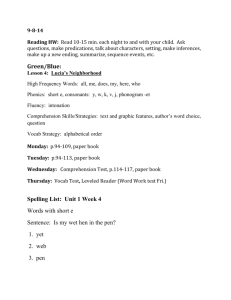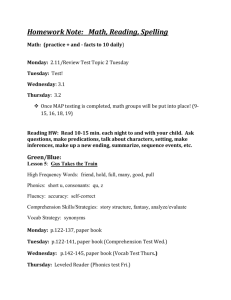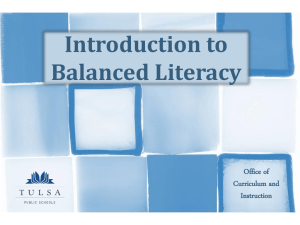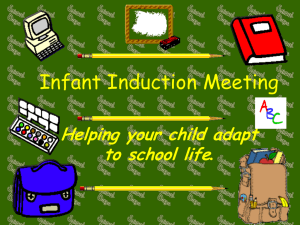Reading Instructional Calendar
advertisement
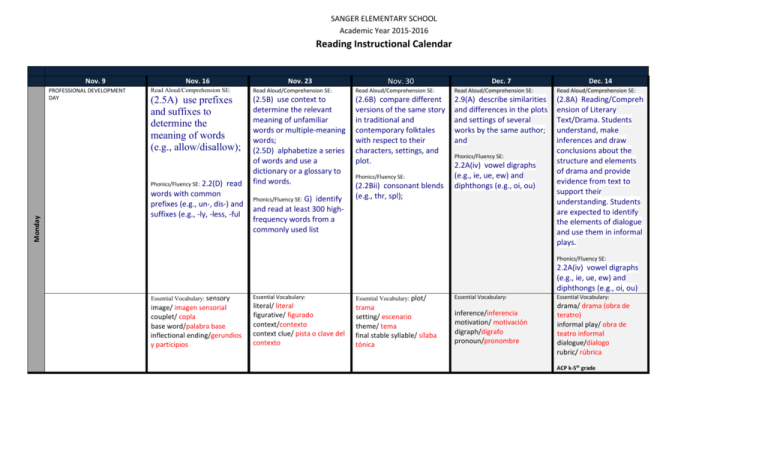
SANGER ELEMENTARY SCHOOL Academic Year 2015-2016 Reading Instructional Calendar Nov. 9 PROFESSIONAL DEVELOPMENT DAY Nov. 16 Nov. 30 Dec. 7 Dec. 14 Read Aloud/Comprehension SE: Read Aloud/Comprehension SE: Read Aloud/Comprehension SE: Read Aloud/Comprehension SE: (2.5A) use prefixes and suffixes to determine the meaning of words (e.g., allow/disallow); (2.5B) use context to determine the relevant meaning of unfamiliar words or multiple-meaning words; (2.5D) alphabetize a series of words and use a dictionary or a glossary to find words. (2.6B) compare different versions of the same story in traditional and contemporary folktales with respect to their characters, settings, and plot. 2.9(A) describe similarities and differences in the plots and settings of several works by the same author; and (2.8A) Reading/Compreh ension of Literary Text/Drama. Students understand, make inferences and draw conclusions about the structure and elements of drama and provide evidence from text to support their understanding. Students are expected to identify the elements of dialogue and use them in informal plays. 2.2(D) read words with common prefixes (e.g., un-, dis-) and suffixes (e.g., -ly, -less, -ful Phonics/Fluency SE: Monday Nov. 23 Read Aloud/Comprehension SE: G) identify and read at least 300 highfrequency words from a commonly used list Phonics/Fluency SE: Phonics/Fluency SE: (2.2Bii) consonant blends (e.g., thr, spl); Phonics/Fluency SE: 2.2A(iv) vowel digraphs (e.g., ie, ue, ew) and diphthongs (e.g., oi, ou) Phonics/Fluency SE: 2.2A(iv) vowel digraphs (e.g., ie, ue, ew) and diphthongs (e.g., oi, ou) Essential Vocabulary: sensory image/ imagen sensorial couplet/ copla base word/palabra base inflectional ending/gerundios y participios Essential Vocabulary: literal/ literal figurative/ figurado context/contexto context clue/ pista o clave del contexto Essential Vocabulary: plot/ Essential Vocabulary: Essential Vocabulary: trama setting/ escenario theme/ tema final stable syllable/ sílaba tónica inference/inferencia motivation/ motivación digraph/dígrafo pronoun/pronombre drama/ drama (obra de teratro) informal play/ obra de teatro informal dialogue/dialogo rubric/ rúbrica ACP k-5th grade SANGER ELEMENTARY SCHOOL Academic Year 2015-2016 Reading Instructional Calendar Nov. 9 Nov. 23 Nov. 30 Read Aloud/Comprehension SE: Read Aloud/Comprehension SE: Read Aloud/Comprehension SE: Read Aloud/Comprehension SE: ask relevant questions, seek clarification, and locate facts and details about stories and other texts and support answers with evidence from text; 2.5A) use prefixes and suffixes to determine the meaning of words (e.g., allow/disallow); (11) Reading/Comprehensi on of Literary Text/Sensory Language. Students understand, make inferences and draw conclusions about how an author's sensory language creates imagery in literary text and provide evidence from text to support their understanding. Students are expected to recognize that some words and phrases have literal and non-literal meanings (e.g., take steps). Phonics/Fluency SE: G) identify and read at least 300 highfrequency words from a commonly used list (2.6A) identify moral lessons as themes in wellknown fables, legends, myths, or stories; and Essential Vocabulary: Essential Vocabulary: plot/ 2.3B 2.2(B)v use common syllabication patterns to decode words including: (v) r-controlled vowels (e.g., per-fect, corner); Phonics/Fluency SE: Tuesday Nov. 16 (G) identify and read at least 300 highfrequency words from a commonly used list Phonics/Fluency SE: Essential Vocabulary: sensory Essential Vocabulary: sensory image/imagen sensorial rhyme/ rima rhythm/ ritmo repetition/ repetición image/ imagen sensorial couplet/ copla base word/palabra base inflectional ending/gerundios y participios literal/ literal figurative/ figurado context/contexto context clue/ pista o clave del contexto Phonics/Fluency SE: (2.2Bii) consonant blends (e.g., thr, spl); Dec. 7 Read Aloud/Comprehension SE: (2.9 B) describe main characters in works of fiction, including their traits, motivations, and feelings. Phonics/Fluency SE: 2.2A(iv) vowel digraphs (e.g., ie, ue, ew) and diphthongs (e.g., oi, ou) Dec. 14 Read Aloud/Comprehension SE: (2.8A) Reading/Compreh ension of Literary Text/Drama. Students understand, make inferences and draw conclusions about the structure and elements of drama and provide evidence from text to support their understanding. Students are expected to identify the elements of dialogue and use them in informal plays. Phonics/Fluency SE: 2.2A(iv) vowel digraphs (e.g., ie, ue, ew) and diphthongs (e.g., oi, ou) trama setting/ escenario theme/ tema final stable syllable/ sílaba tónica Essential Vocabulary: inference/inferencia motivation/ motivación digraph/dígrafo pronoun/pronombre Essential Vocabulary: drama/ drama (obra de teratro) informal play/ obra de teatro informal dialogue/dialogo rubric/ rúbrica ACP k-6th grade SANGER ELEMENTARY SCHOOL Academic Year 2015-2016 Reading Instructional Calendar Nov. 9 Read Aloud/Comprehension SE: Read Aloud/Comprehension SE: 2.3(C) (2.7A) Reading/Comprehe nsion of Literary Text/Poetry. Students understand, make inferences and draw conclusions about the structure and elements of poetry and provide evidence from text to support their understanding. Students are expected to describe how rhyme, rhythm, and repetition interact to create images in poetry. establish purpose for reading selected texts and monitor comprehension, making corrections and adjustments when that understanding breaks down (e.g., identifying clues, using background knowledge, generating questions, re-reading a portion aloud). Wednesday Nov. 16 Phonics/Fluency SE: 2.2(F) identify and read contractions (e.g., haven't, it's Nov. 23 Thanksgiving Break Nov. 30 Read Aloud/Comprehension SE: (2.6B) compare different versions of the same story in traditional and contemporary folktales with respect to their characters, settings, and plot. Phonics/Fluency SE: (2.2Bii) consonant blends (e.g., thr, spl); Dec. 7 Read Aloud/Comprehension SE: (Fig 19 D) make inferences about text using textual evidence to support understanding; Phonics/Fluency SE: 2.2B(vi) vowel digraphs and diphthongs (e.g., boyhood, oat-meal); Dec. 14 Read Aloud/Comprehension SE: (2.8A) Reading/Compreh ension of Literary Text/Drama. Students understand, make inferences and draw conclusions about the structure and elements of drama and provide evidence from text to support their understanding. Students are expected to identify the elements of dialogue and use them in informal plays. Phonics/Fluency SE: 2.2(D) read words with common prefixes (e.g., un-, dis-) and suffixes (e.g., -ly, -less, -ful Phonics/Fluency SE: 2.2B(vi) vowel digraphs and diphthongs (e.g., boy-hood, oat-meal); Essential Vocabulary: sensory Essential Vocabulary: sensory Essential Vocabulary: plot/ image/imagen sensorial rhyme/ rima rhythm/ ritmo repetition/ repetición image/ imagen sensorial couplet/ copla base word/palabra base inflectional ending/gerundios y participios trama setting/ escenario theme/ tema final stable syllable/ sílaba tónica Essential Vocabulary: Essential Vocabulary: inference/inferencia motivation/ motivación digraph/dígrafo pronoun/pronombre drama/ drama (obra de teratro) informal play/ obra de teatro informal dialogue/dialogo rubric/ rúbrica ACP k-6th grade SANGER ELEMENTARY SCHOOL Academic Year 2015-2016 Reading Instructional Calendar Nov. 9 Thursday Read Aloud/Comprehension SE: 2.7A Reading/Comprehens ion of Literary Text/Poetry. Students understand, make inferences and draw conclusions about the structure and elements of poetry and provide evidence from text to support their understanding. Students are expected to describe how rhyme, rhythm, and repetition interact to create images in poetry. Nov. 16 Nov. 23 Read Aloud/Comprehension SE: (Fig 19 C) monitor and adjust comprehension (e.g., using background knowledge, creating sensory images, rereading a portion aloud, generating questions); Phonics/Fluency SE: 2.2(D) read words with common prefixes (e.g., un-, dis-) and suffixes (e.g., -ly, -less, -ful Thanksgiving Day Nov. 30 Dec. 7 Dec. 14 Read Aloud/Comprehension SE: Read Aloud/Comprehension SE: Read Aloud/Comprehension SE: (F) make connections to own experiences, to ideas in other texts, and to the larger community and discuss textual evidence. Fig 19 E) retell important events in stories in logical order; (2.8A) Reading/Compreh ension of Literary Text/Drama. Students understand, make inferences and draw conclusions about the structure and elements of drama and provide evidence from text to support their understanding. Students are expected to identify the elements of dialogue and use them in informal plays. Phonics/Fluency SE: 2.2G) identify and read at least 300 high-frequency words from a commonly used list Phonics/Fluency SE: 2.2B(vi) vowel digraphs and diphthongs (e.g., boyhood, oat-meal); Phonics/Fluency SE: 2.2(G) identify and read at least 300 high-frequency words from a commonly used list Phonics/Fluency SE: 2.2B(vi) vowel digraphs and diphthongs (e.g., boy-hood, oat-meal); Essential Vocabulary: sensory Essential Vocabulary: sensory Essential Vocabulary: plot/ image/imagen sensorial rhyme/ rima rhythm/ ritmo repetition/ repetición image/ imagen sensorial couplet/ copla base word/palabra base inflectional ending/gerundios y participios trama setting/ escenario theme/ tema final stable syllable/ sílaba tónica Essential Vocabulary: Essential Vocabulary: inference/inferencia motivation/ motivación digraph/dígrafo pronoun/pronombre drama/ drama (obra de teratro) informal play/ obra de teatro informal dialogue/dialogo rubric/ rúbrica ACP BEGIN K-5th grade ACP k-6th grade SANGER ELEMENTARY SCHOOL Academic Year 2015-2016 Friday Reading Instructional Calendar Nov. 9 Nov. 16 Read Aloud/Comprehension SE: 2.7 A Read Aloud/Comprehension SE: (Fig Reading/Comprehension of Literary Text/Poetry. Students understand, make inferences and draw conclusions about the structure and elements of poetry and provide evidence from text to support their understanding. Students are expected to describe how rhyme, rhythm, and repetition interact to create images in poetry. 19 C) monitor and adjust comprehension (e.g., using background knowledge, creating sensory images, rereading a portion aloud, generating questions); (G) identify and read at least 300 highfrequency words from a commonly used list Phonics/Fluency SE: Nov. 23 Nov. 30 Dec. 7 Dec. 14 Read Aloud/Comprehension SE: Read Aloud/Comprehension SE: Read Aloud/Comprehension SE: (2.6B) compare different versions of the same story in traditional and contemporary folktales with respect to their characters, settings, and plot. (Fig 19 F) make connections to own experiences, to ideas in other texts, and to the larger community and discuss textual evidence. Phonics/Fluency SE: 2.2G) identify and read at least 300 high-frequency words from a commonly used list (2.8A) Reading/Compreh ension of Literary Text/Drama. Students understand, make inferences and draw conclusions about the structure and elements of drama and provide evidence from text to support their understanding. Students are expected to identify the elements of dialogue and use them in informal plays. 2.2G) identify and read at least 300 high-frequency words from a commonly used list Phonics/Fluency SE: Phonics/Fluency SE: 2.2(G) identify and read at least 300 high-frequency words from a commonly used list Phonics/Fluency SE: 2.2G) identify and read at least 300 highfrequency words from a commonly used list Essential Vocabulary: sensory Essential Vocabulary: sensory Essential Vocabulary: plot/ image/imagen sensorial rhyme/ rima rhythm/ ritmo repetition/ repetición image/ imagen sensorial couplet/ copla base word/palabra base inflectional ending/gerundios y participios trama setting/ escenario theme/ tema final stable syllable/ sílaba tónica Essential Vocabulary: Essential Vocabulary: inference/inferencia motivation/ motivación digraph/dígrafo pronoun/pronombre drama/ drama (obra de teratro) informal play/ obra de teatro informal dialogue/dialogo rubric/ rúbrica ACP k-5th grade ACP k-6th grade



